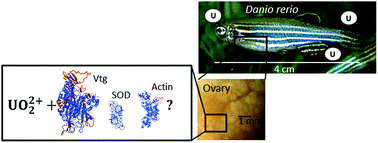In vivo identification of potential uranium protein targets in zebrafish ovaries after chronic waterborne exposure
Abstract
Ecotoxicological studies have indicated the reprotoxicity of uranium (U) in zebrafish, but its molecular mechanisms remain unclear. Due to the non-covalent nature of U–protein complexes, canonical proteomics approaches are often not relevant as they usually use denaturating reagents or solvents. In this study, non-denaturating (ND) methods were used to obtain insight into the nature of U potential targets in ovaries of reproduced and non-reproduced zebrafish after 20 days of exposure to an environmentally relevant U concentration (20 μg L−1). After the ND sample preparation, 1-dimensional (SEC) and 2-dimensional (OGE × SEC) separations followed by ICP-sector-field MS measurements (U, P, Fe, Cu, and Zn) enabled the determination of chemical characteristics (MW, pI) of the metal–protein complexes. Phosphorus and U coelution confirmed the affinity of U for P-containing proteins. In addition, 2D separation allowed the discrimination of Fe-metalloproteins as potential U targets. Finally, 20 protein candidates for U complexation were identified after tryptic digestion conditions by LC-ESI FT MS and a database search. Potential U targets were mainly involved in three biological processes: oxidative stress regulation (SOD, GST), cytoskeleton structure (actin) and embryo early development (vtg, initiation factor).

- This article is part of the themed collection: Metals in marine biochemistry


 Please wait while we load your content...
Please wait while we load your content...